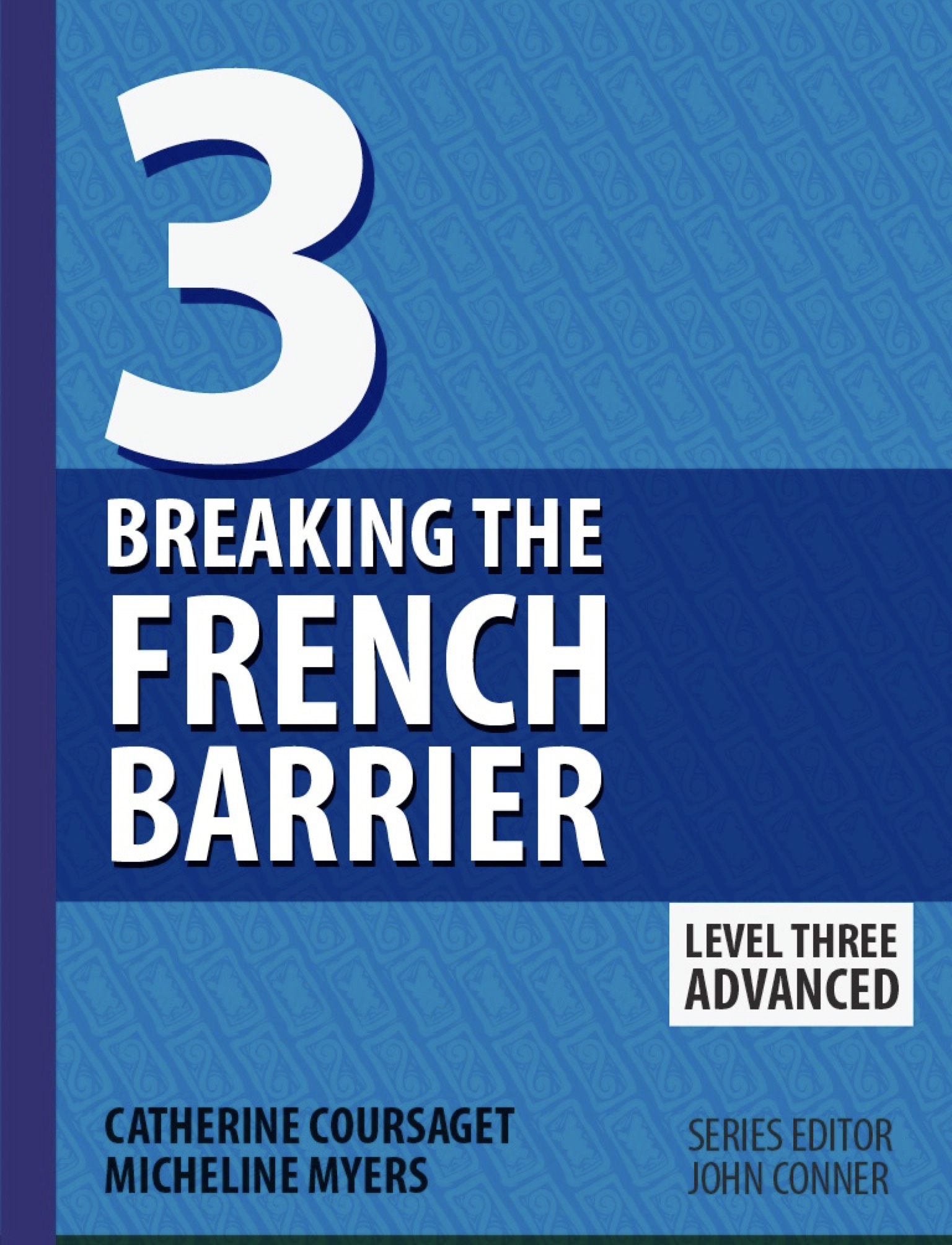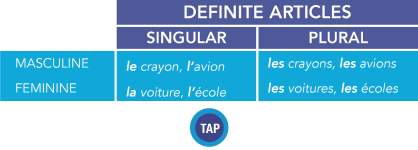LEÇON 3 / Advanced

LES ARTICLES DÉFINIS, INDÉFINIS ET PARTITIFS
The article l’ is used before any singular noun (masculine or feminine) beginning with a vowel, and in front of nouns beginning with a silent “h.”
Note: There are, however, exceptions to this rule with “h”: e.g., le haricot, le héros, la honte.
When definite articles follow à and de, contractions are formed:
ATTENTION
Remember, there is no contraction formed with either l’ or la.
 EXAMPLES
EXAMPLES
Je vais à l’école dans le centre de Bruxelles.
I am going to school in the center of Brussels.
Tu vas à la piscine.
You are going to the pool.

À quelle heure est-il revenu de la Foire du Midi?
At what time did he come back from the “Foire du Midi”?
Elle a téléphoné de l’hôpital.
She called from the hospital.
WHEN DO YOU USE DEFINITE ARTICLES?
1. to designate nouns in an abstract or general sense
 EXAMPLES
EXAMPLES
Le fer est plus dur que le coton.
Iron is harder than cotton.
L’argent ne fait pas le bonheur.
Money does not bring happiness.
2. before titles (except when directly addressing a person)
 EXAMPLES
EXAMPLES
J’ai vu le président à la télé.
I saw the president on TV.
BUT: Bonne nuit, docteur Jekyl!.
Good night, Doctor Jekyl!
3. before a language (except after “en”)
 EXAMPLES
EXAMPLES
Nous apprenons le français.
We are learning French.
ATTENTION
Do not add a definite article after “en.”

Elle a écrit ce poème en zulu.
She wrote that poem in Zulu.
4. before days of the week when an action regularly happens on that day
 EXAMPLES
EXAMPLES
Nous n’allons pas à l’école le dimanche.
We don’t go to school on Sundays.
Mes parents vont souvent au cinéma le samedi.
My parents often go to the movies on Saturdays.
BUT: Thomas et Louise se marient dimanche.
Thomas and Louise are getting married on Sunday.
5. to designate names of countries, continents, states, mountains, and rivers
 EXAMPLE
EXAMPLE
La Belgique est plus petite que les États-Unis.
Belgium is smaller than the United States.
6. often with parts of the body (in place of a possessive adjective as in English)
 EXAMPLES
EXAMPLES
Je me suis brossé les dents.
I brushed my teeth.
Levez la main!
Raise your hand!
7. with names of seasons and colors (except after “en” or “au”... e.g., en hiver, en été, en automne, au printemps)
 EXAMPLES
EXAMPLES
J’aime l’hiver parce que je joue au squash.
I like winter because I play squash.
Le gris est une couleur sombre.
Gray is a gloomy color.
8. with dates
 EXAMPLES
EXAMPLES
On est le 14 juillet.
Today is July 14th.
Nous nous marierons le 6 septembre.
We will get married on September 6th.
9. before nouns of weight and measure
 EXAMPLES
EXAMPLES
Ces pommes coûtent quatre dollars le kilo.
These apples cost four dollars a kilo.
Il a payé ces oeufs biologiques dix dollars la douzaine.
He paid ten dollars a dozen for those organic eggs.
 EXAMPLES
EXAMPLES
Le docteur Paul Farmer va à l’hôpital le matin.
Doctor Paul Farmer goes to the hospital in the mornings.
Nous regardons la télévision le soir.
We watch television in the evenings.
L’année prochaine tu iras à l’université à Bruxelles.
Next year you will go to college in Brussels.
2. LES ARTICLES INDÉFINIS ET LE PARTITIF
The indefinite article refers to nouns in a general way, without identifying a specific object or person.
 EXAMPLES
EXAMPLES
J’ai vu une souris dans le placard.
I saw a mouse in the closet.
Hier soir nous avons vu un bon film du cinéaste Jean-Luc Godard.
Last night we saw a good film of the cinematographer Jean-Luc Godard.
Des means “some” or “any” and is often not translated at all in English.
 EXAMPLES
EXAMPLES
Je connais un magasin qui vend des disques de rap en plusieurs langues.
I know a shop that sells rap CDs in several languages.
Avez-vous encore des billets pour le “Super Bowl”?
Do you still have (any) tickets for the Super Bowl?
WHEN DO YOU USE THE PARTITIVE ARTICLE?
In French, whenever you are referring to “a part” of something – often referred to as “any” or “some” in English – you must use a partitive article. Keep in mind that while the French partitive means “part,” “some,” or “any,” sometimes none of these words are used in English.
 EXAMPLES
EXAMPLES
Le matin il boit du jus d’orange.
In the morning he drinks (some) orange juice.
Est-ce que vous avez du temps?
Do you have (any) free time?
Here are the four forms of the partitive:
 EXAMPLES
EXAMPLES
Est-ce que vous voulez du lait dans votre café?
Do you want (some) milk in your coffee?
Il a acheté de l’essence à la station service.
He bought gas at the gas station.
WHAT SITUATIONS CALL FOR THE USE OF DE (D’)?
“De (d’)” replaces the indefinite articles “un, une, des” and the partitive articles “du, de la, de l’, des” in the following two situations:
1. in negative sentences
 EXAMPLES
EXAMPLES
Tu as de la chance, mais moi je n’ai pas de chance.
You are lucky, but I am not lucky.
Est-ce que vous avez des fraises? –Non, je n’ai pas de fraises aujourd’hui.
Do you have (any) strawberries? –No, I don’t have (any) strawberries today.
Pierre a un chien, mais moi, je n’ai pas de chien.
Pierre has a dog, but I don’t have a dog.
2. after expressions of quantity
Common adverbs of quantity:
assez de enough
beaucoup de a lot of
combien de? how much?/how many?
trop de too much
un peu de a little
Common nouns of quantity:
une boîte de a box of
une bouteille de a bottle of
un morceau de a piece of
un sac de too much
une tasse de a cup of
un verre de a glass of
 EXAMPLES
EXAMPLES
Combien de joueurs est-ce qu’il y a dans une équipe de basketball?
How many players are there on a basketball team?
Je voudrais une bouteille d’Orangina, s’il vous plaît.
I would like a bottle of Orangina, please.
ATTENTION
The adjective “plusieurs” (several) is always followed
directly by a plural noun.

 EXAMPLE
EXAMPLE
Je vais téléphoner à plusieurs amis ce soir.
I will call several friends tonight.
ATTENTION
“La plupart” (most of) is followed by “de” + definite article.
 EXAMPLES
EXAMPLES

La plupart des enfants aiment les bonbons.
Most children like candy.
La plupart des élèves n’aiment pas les devoirs.
Most students don’t like homework.
3. before plural nouns
“Des” also becomes “de” or “d’” in front of plural nouns that are preceded by an adjective.
 EXAMPLES
EXAMPLES
Elle a des problèmes.
She has problems.
Elle a d’énormes problèmes.
She has huge problems.
BUT: Elle a des problèmes intéressants.
She has interesting problems.
Nous avons vu des éléphants au Congo.
We saw elephants in the Congo.
Nous avons vu de gros éléphants au Congo.
We saw fat elephants in the Congo.
BUT: Nous avons vu des éléphants élégants au Congo.
We saw elegant elephants in the Congo.







